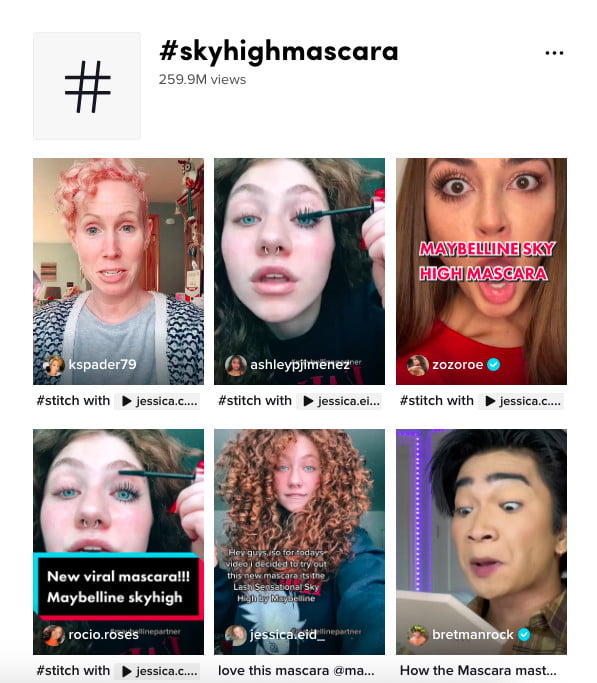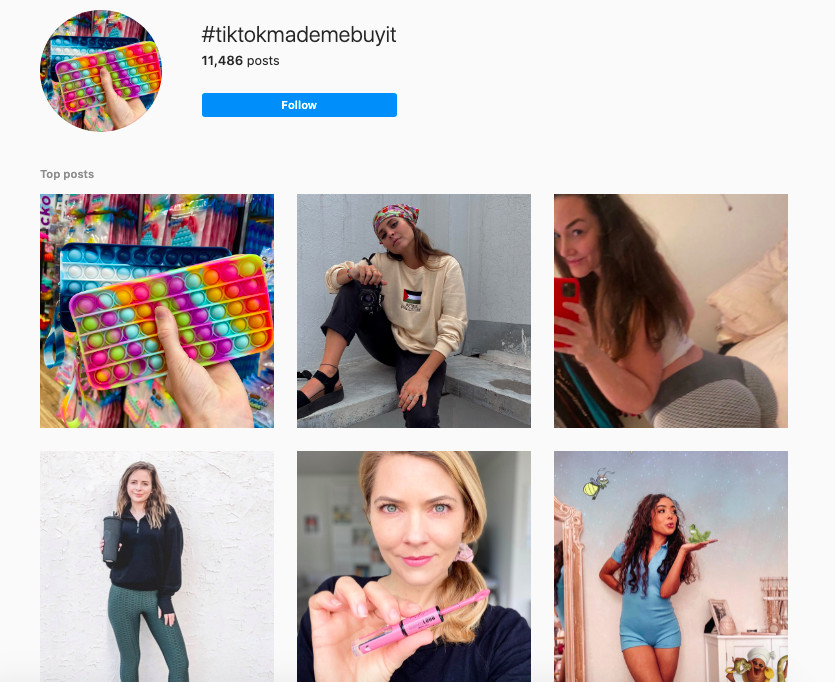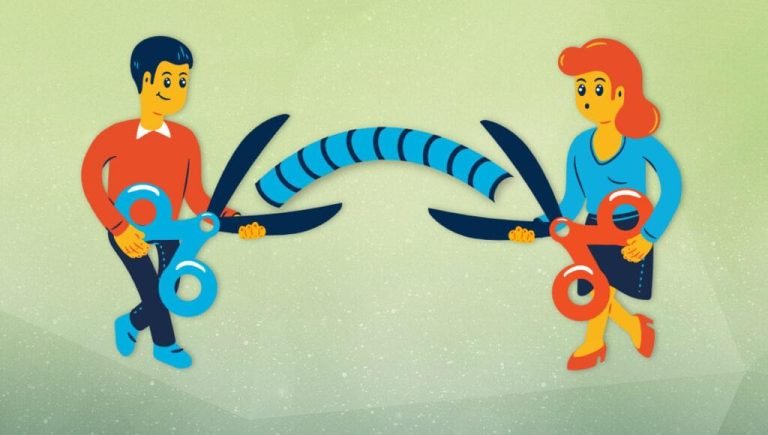A couple months ago, I was hunting for the holy grail. Somewhere within the chaotic aisles of a Target in the suburbs of Washington, DC, was a magic wand that would somehow transform my very short, very thin, very flat, and very blonde eyelashes into the lash equivalent of a mink coat. Granted, most mascara commercials promise as much, but this was different. I’d actually seen it happen, on TikTok.
The video went like this: A girl shows the vast difference between her normal eye and the one anointed with the mascara, then the video cuts to another user whose lashes curl up in the exact same impossible way. The second video acted as confirmation that it wasn’t all a prank, that These Are Not Paid Actors. It was, in other words, like a really good, really short infomercial.
The magic wand’s real name is the Maybelline Lash Sensational Sky High mascara, which comes in a rather demure rosy tube but otherwise looks exactly like the other 12 billion products in any makeup aisle. The only way I knew I’d arrived at the right place was when I came across a devastating scene: Two teenage girls staring at a single empty rack.
“It’s sold out,” one of them moaned, and I understood exactly what “it” was.

Here is an incomplete list of products that have become difficult or impossible to buy because of their popularity on TikTok: a mysterious cleaning paste called The Pink Stuff, a specific pair of Aerie leggings and a different pair of Zara jeans, Isle of Paradise tanning spray, Elf concealer, Dr. Jart Cicapair color corrector, Cat Crack catnip, the Prepdeck kitchen organizer, feta cheese (all-encompassing), and an Eos shaving cream that one user promised would “bless your fucking cooch.” My editor often laments that products by her longtime favorite low-cost skincare brand, CeraVe, are constantly sold out because of the company’s exploding popularity on TikTok. Last summer it was almost impossible to find roller skates due to a handful of viral videos of girls speeding through their hometowns.
There’s now so much stuff that’s gone viral on TikTok that people have opened stores dedicated to it: A 15-year-old student opened a store in his local mall called “Viral Trends NY,” which carries omnipresent TikTok doodads like Martinelli’s apple juice and Squishmallows stuffed animals. “Everything in this store fis super high demand and you really can’t find it anywhere else except on eBay fully marked up,” he told a local news broadcast; a similar shop also exists in Indiana. Downtown Manhattan has its own “TikTok Block,” where two big TikTokers have opened shops with curated vintage clothing. There is now so much stuff that’s gone viral on TikTok that the factories producing those products have gotten on TikTok and now have a hand in making them go viral in the first place.
This is only the first chapter of the “TikTok made me buy it” phenomenon, referring to the culture of compelling product review videos and the many impossibly stylish people who flaunt their lifestyles on the platform. Though TikTok is still in the testing phase for its in-app shopping feature, its Chinese counterpart Douyin netted a whopping $26 billion of e-commerce transactions within its first year. Currently, TikTok allows certain creators and businesses in the UK and Indonesia to sell products within its TikTok Shop, though the feature doesn’t yet exist in the US. But it’s almost certainly coming. What effect that might have on American consumerism depends on whom you ask.
Say you’re a teenager — or anyone, really — who wants to get very famous, very fast. There are worse places to go than TikTok, the app responsible for the careers of thousands of previously unknown normal people who’ve built up enough of a following to land their own pages on the website Famous Birthdays. What TikTok has done to turn an enormous swath of human beings into microinfluencers, it has also done to the music industry, where many of the top songs currently on the Billboard charts are simply the ones that have gone TikTok viral most recently. Now, the same phenomenon is happening to stuff.
There are a few reasons why TikTok is so adept at blowing up one thing — a song, a beauty product, a trend, a person — very quickly and forgetting about it several days later. The first is its algorithm, which is unmatched at identifying what individual users want to see and serving them more of it, sprinkled with a well-calibrated dose of randomness.
The course of a viral video tends to go like this: TikTok shows it to a handful of people on their For You pages, and if those people engage with it, it’ll show a few more. Videos that break out tend to snowball quite quickly, often in a matter of hours or overnight. Videos that don’t — the vast, vast majority — peter out entirely. That means that when you open the app, what you’re seeing is the culmination of what everyone else has decided to like or engage with, yet, of course, orchestrated by the invisible hand of the ever-changing TikTok algorithm and the people who control it.
The other reason is TikTok’s 60-second time limit: People can watch many more TikToks in the amount of time that they could watch, say, a YouTube review. That also gives it a lower barrier of entry, welcoming more creators onto the platform: To run a YouTube channel, you need equipment and some level of expertise, whereas with TikTok, all you need is your phone. The ability to duet, stitch, and share sounds encourages TikTok’s remix culture, wherein videos can capitalize off of each other’s success.
The prevalence of building off of others’ work has been a boon for a certain type of content: the product test. It was in this sort of video that I was first introduced to the magic mascara, and it turned out that this is how the mascara went viral in the first place, by people reacting to the original video in order to confirm that yes, this mascara was actually magic.
But the first wasn’t quite as spontaneous. Jessica Eid, a 19-year-old at Arizona State, had joined TikTok last fall as a bet with her friends to see who could get the most views. Jessica, explaining the bet in her first TikTok, won. It was about a week later that a Maybelline publicist reached out, asking if they could send her their new mascara and if she’d make a video about what she thought about it. No money was offered. “I was like, ‘Of course, that’s Maybelline, they’re so cool!” Jessica told me. After the video blew up, Jessica says Maybelline paid her in a five-figure deal to use her video in marketing materials for six months.
Jessica is only one example of someone who went viral because they recommended a certain product. If the idea of “influencerhood” is someone who advises you how to spend your time and money by making a certain type of life look enviable, recommendation influencers are the ur-example. The internet is full of them — there are influencers devoted to recommending Madewell jeans, seasonal Trader Joe’s snacks, even cheese plate accouterments. Creators who’ve become adept at the skill of evangelizing have built it into wildly lucrative businesses.
22-year-old Mikayla Nogueira is one such influencer, who, like many people, joined TikTok in March of 2020. Within days, she’d found out that she’d been temporarily laid off from her job at the local Ulta beauty store and that she wouldn’t be able to finish her senior year of college in person. “I needed to find something to do with my time,” she told me.
That month, a particular transformation trend called the catfish challenge — wherein you show your face before and after putting on dramatic makeup — was popular. Mikayla’s first stab at the format blew up. “Once I went viral, I essentially said to myself, ‘Mikayla, this has been your dream your entire life, to teach the world beauty and talk about makeup. This is your moment,” she said. “So I started putting out videos every single day: reviews, tutorials, lifestyle videos, just to see what people would like.”
It turns out that the people really, really liked her product reviews, which were peppered with refreshing honesty and a thick Boston accent that endeared her to viewers. While her expertise at Ulta was in higher-end makeup, her audience begged her to incorporate more accessible products they could find at CVS or Walgreens. “A lot of the viral products we see are drugstore products,” she said. “Drugstore makeup is crushing it right now.” Some popular topics: foundation (“People are always looking for a good foundation”), self-tanner, and anything affordable that allows customers to at least be able to try it out themselves, even if they end up hating it.
“It’s this weird chain reaction,” she said, “One person puts a video up about how that product changed their skin, and then it goes a little bit viral and then everyone else starts buying it and stitching that video or doing their own review.”
That chain of events isn’t always positive. KVD Beauty’s Good Apple foundation was celebrated widely on TikTok until people began actually wearing it for a whole day and realizing that it left them with creased, oily faces after a few hours. “Then it started going viral for bad reasons, and that was kind of the end of it,” she said. Also, sometimes the advice is bad. “Vaseline went viral for like, slathering it all over your face. I thought that was a little bit weird because … not everyone should be doing that.”
After about six months on TikTok, Mikayla started receiving her first requests to endorse specific beauty brands. She’d review a product positively, then that video would go viral, then the brand would reach out, hoping to build a longer-lasting advertising partnership. For TikTokers, the first sponsorship offer is a huge milestone; today, she fields messages and emails from brands every day and sometimes coaches them on how TikTok works. She says 99 percent ask for promotion on TikTok versus Instagram. “TikTok is the viral platform, and brands want their product to sell out,” she said. I asked her about how much money she’d made in the past year. “I just finished filing my taxes,” she said. “It’s upwards of a million.”
According to the last hundred or so years of marketing research, people like Mikayla and platforms like TikTok are almost perfectly suited to sell you things. Unsurprisingly, shoppers tend to buy from brands, or in this case influencers, they deem trustworthy. On a platform like TikTok, where inauthenticity is rabidly sniffed out and policed, the most popular influencers tend to be the ones who ultimately feel like believable salespeople. TikTok operates similarly to traditional word-of-mouth marketing, widely considered the most effective selling strategy that exists. It also incorporates viral marketing, sometimes called “online word-of-mouth,” which allows information and ads to spread much farther.
People are spending more of their money on social platforms; the number of shoppers buying via social commerce grew by 25 percent from 2019 to 2020, according to an Insider Intelligence report. Not only does social media encourage conspicuous consumption, but social platforms have also tried to erase the friction between seeing a product online and actually pressing “purchase,” as my colleague Terry Nguyen has reported extensively. A model for what that could look like already exists in Asia, which already has sophisticated in-app shopping features. Yet American consumers seem to want something different from those in China, who tend to view shopping as a hobby. “We have a greater focus on entertainment and community, and allow viewers to build an emotional connection with the seller,” Danielle Li, the founder of the livestream shopping marketplace Popshop Live, told Nguyen.
TikTok is perfectly suited to build those emotional connections, thanks to its prevalence of front-facing camera videos that often feel as though you’re FaceTiming with a friend who happens to be really excited about something she just bought. With the brevity of a tweet, the intimacy of YouTube, and the ability to riff off of others’ content, there’s nowhere better to make a convincing pitch and have it reach a potential audience of millions.
When Hyram Yarbro, a 25-year-old in Hawaii, started making online skincare content, he posted primarily on YouTube, criticizing the DIY and natural skincare experiments of celebrities and influencers that came across his feed and educating viewers on science-backed strategies to reduce skin sensitivity and irritation. When he moved to TikTok in March 2020, however, what stuck was product recommendations.
“On YouTube, it’s giving people the feeling that they’ve walked away from your content learning something pretty substantial,” he explained. “TikTok is more stripped away, because people want content that feels like you’re literally just hanging out with a friend.” He noticed that many of his followers seemed to feel directionless in their skincare routines, and his basic recommendations of affordable products from brands like The Ordinary and CeraVe amassed him a following of nearly 7 million.
Like Mikayla, he too has had a wildly successful year. Last summer, he told the New York Times he expected to become a multimillionaire within the year; though he wouldn’t confirm that he’d reached that goal, he told me he was excited about the prospect of getting involved in philanthropy and social causes.
Is TikTok really all that different from more traditional marketing tactics? Jonah Berger, professor of marketing at the Wharton School and author of Contagious: Why Things Catch On, reminded me that the internet didn’t invent the concept of sharing ideas. In his book, he notes six reasons why people share things, all of which seem to apply to TikTok, including sharing out of a desire for social currency and humans’ love of delivering useful information. “The underlying psychological drivers are pretty consistent over time, certain platforms may encourage one or another driver, but the drivers themselves don’t necessarily change,” he told me.
He also said that many more established brands have often been wary of virality. “Viral is often a flash in the pan; here today, gone tomorrow,” he said. “We don’t need 10 million people sharing our thing today and then talking about something completely different next week. We need them to continue talking about and sharing our stuff, whether online or off.” Another reason to be skeptical of virality, he says, is that if the main motivator for you to share something is solely to show that you were the first person in your group to discover it, that thing will be much more likely to die out quickly. “If it’s all about ‘I was here first,’ it’s not going to have as long of a lifespan.”
Much like products have had their viral moments on YouTube and Instagram that reflect the features of the platform — think LOL Surprise! Dolls, which relied on audience watch time as the toys were unwrapped to build suspense, or “the Amazon coat,” which spread on Instagram through a word-of-mouth influencer chain — TikTok’s main feature is its speed. That means TikTok products have a higher chance of being a flash in the pan rather than a long-term mainstay. When you look up Google search trends for many TikTok viral products — Maybelline Sky High mascara, KVD Good Apple foundation, Dr. Jart Cicapair, Squishmallows, and Cat Crack among them — you’ll see a huge spike, inevitably followed by a crash.
What platforms like TikTok and Instagram have allowed companies to do, however, is observe the kinds of conversations that might otherwise be private. Social listening, or the practice of brands checking in on social media discourse, has largely replaced the idea of the “focus group” that conjures images of Don Draper asking a group of women about their favorite lipstick.
There is another effect of using an algorithmic, visual platform as a recommendation engine: The algorithm does not necessarily prioritize the truth. Just like the golden age of Facebook News wrought clickbait headlines that overpromised on a given article’s content, TikTok can favor outlandish or extreme reviews that categorize products or treatments as uniformly good or bad. And the stakes can be quite high: As one plastic surgeon told the New York Times after noticing swaths of clients asking for procedures that had recently gone viral, “We talk about TikTok all the time in my office, and I think it might be worse than other platforms because people are really looking to create content with that wow factor, the thing that will go viral, even if it’s not grounded in science.”
More knowledgeable creators often complain of TikTok’s ability to flatten nuance in product reviews. Tiara Willis, the esthetician behind the popular Twitter account @MakeupForWOC, laments the amount of factually incorrect claims in efforts to gain views. “It’s a lot of experiments and DIYs, like ‘I put pineapples on my face and it cleared my skin, and now a million people are trying it,’” she said.
On the flip side, she explains, there’s also misguided fear-mongering about perfectly safe ingredients. “I find a lot of people saying that some ingredient will give you breast cancer and it’s like, wait, in that study that you’re referencing, that was fed to rats, and it was fed an extremely high amount. It’s not always applicable to real-life situations.” Yet when actual chemists and dermatologists try to respond, the videos typically don’t get the same amount of engagement because the claims aren’t as shocking.
TikTok tends to give its users a sense of urgency and universality, the idea that everyone is doing this thing right now. A video could get a million views — a lot, certainly, but not newsworthy by TikTok standards — and a person watching it might reasonably assume that means it’s massively popular. What they’re less likely to consider is that it’s just one of hundreds or thousands of videos going viral in different pockets of TikTok that day. That’s where you get scores of misleading news articles claiming that “this thing is going viral on TikTok!”: Just because a video of a certain recipe has a few million views doesn’t mean that tons of people are suddenly cooking it. (Take, for instance, the entire existence of “cheugy” or headlines like “Everyone’s Singing Sea Shanties,” when in reality there were only a handful of actual sea shanty creators that happened to go viral for about a week.)
The increasingly rapid trend cycle has made many of the same TikTok users reevaluate their relationship to consumerism. During a year when one of the main sources of joy was waiting for packages to arrive, Hyram also started thinking about his own role. “People are over the huge skincare craze that everyone went through last year where they were scrambling to buy as many drugstore skincare products as they could,” he said. “I think people are less focused on hyperconsumerism and product obsession right now and more critically approaching which products they want in their routine.”
It is true that many of the products that go viral on TikTok — LED lights, Therabreath mouthwash, boxes for cable management, mass-produced macrame hangings — tend to be cheap and accessible on platforms like Amazon, therefore making them more disposable. Some companies are hoping to cash in by marketing products specifically for TikTok. “Brands have, like, Chief Tiktok Officers now,” said Gregg Witt, a marketing expert who advises companies on how to target young people. “Toys and fashion are areas where you see it a lot. Creating products or experiences that suit themselves for narrow vertical — that’s a real thing.”
As more brands align themselves with creators, the question of how much that exposure is worth is largely unanswerable. “It’s still the Wild West,” Witt said. “It’s the biggest complaint from creators because honestly, I don’t think that [sponsorship rates] will ever be completely standardized. It’s not the NBA or the NFL, there’s no way that dancing people on TikTok are going to become a union. They’re basing their values off of the deals that have been put in front of them or what their friend has been getting.” He suspects that as more people join the creator economy, those who don’t find their niche and have business and management acumen will be pushed out.

Brand sponsorships still account for the vast majority of influencer deals; one study from NeoReach and Influencer Marketing Hub found that 77 percent of creators relied on sponsorships as their highest source of income, three times more than every other revenue stream combined. Yet affiliate links, which net influencers a cut of the sales they make when people buy products based on their recommendation, are growing. Affiliate marketing spending is projected to reach $8.2 billion by 2022, up from $5.4 billion in 2017, according to Statista, and 81 percent of advertisers in a Forrester report said they use affiliate marketing, with more than half saying it accounted for more than 20 percent of their annual revenue.
That’s the gold standard of influencer marketing, when someone actually makes a purchase from a creator’s link. But for many creators and their followers, the point of a product review isn’t always to make a sale. It’s just fun to watch, even if no one intends to buy anything. Viral TikTok products, ultimately, are about the thrill of watching other people try new things; a kind of QVC for kids where there’s always something new and shiny to lust over — until next week.
TikTok also doesn’t always necessarily circulate total junk: I’m delighted to say that the mascara did actually turn out to be pretty magical. Of course, the goal of actually trying it out for myself also had to do with the desire to participate in the wider trend, to feel as though I’m somehow connected to the strangers on the internet who rallied around the concept of amazing eyelashes. It’s easy to forget, when you’re lured in this way, that what I’m ultimately doing is giving the L’Oréal corporation $10. It’s a pretty sneaky trick, when you think about it.
Even for entrenched skincare experts like Tiara Willis, TikTok has a particular way of keeping us convinced that the next viral product will be the one that does, actually, change our lives. “I love CeraVe, but I think people are starting to get a little sick of it,” she said. “Everyone’s like, ‘Okay, we get it, it’s great. Is there anything else you recommend?’”






